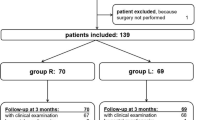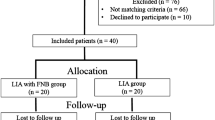Abstract
Purpose
To evaluate the effect of the local infiltration of analgesics for pain after total knee arthroplasty in patients treated with femoral and sciatic peripheral nerve blocks. The secondary objective was to detect differences in analgesic consumption as well as blood loss after local infiltration of analgesics.
Methods
Prospective randomized double-blinded study in patients who underwent a TKA for knee osteoarthritis under spinal anesthesia and treated with femoral and sciatic nerve blocks. This study compared 50 patients treated with local infiltration with ropivacaine, epinephrine, ketorolac and clonidine and 50 patients treated with a placebo with the same technique. The visual analogic score was registered postoperatively at 2, 6, 12, 24, 36, 48 and 72 h after surgery. Analgesic consumption was also registered. Both groups of patients were treated with the same surgical and rehabilitation protocols.
Results
A significant difference of one point was found in the visual analogic pain scores 12 h after surgery (0.6 ± 1.5 vs. 1.7 ± 2.3). There were no significant differences in the visual analogic pain scores evaluated at any other time between 2 and 72 h after surgery. No significant differences were found in the required doses of tramadol or morphine in the postoperative period. Postoperative hemoglobin and blood loss were also similar in both groups.
Conclusion
Adding local infiltration of analgesics to peripheral nerve blocks after TKA surgery only provides minimal benefit for pain control. This benefit may be considered as non-clinically relevant. Moreover, the need for additional analgesics was the same in both groups. Therefore, the use of local infiltration of analgesics treatment in TKA surgery cannot be recommended if peripheral nerve blocks are used.
Level of evidence
I.


Similar content being viewed by others
References
Affas F, Nygårds EB, Stiller CO, Wretenberg P, Olofsson C (2011) Pain control after total knee arthroplasty: a randomized trial comparing local infiltration anesthesia and continuous femoral block. Acta Orthop 82:441–447
Al-Zahrani T, Doais KS, Aljassir F, Alshaygy I, Albishi W, Terkawi AS (2015) Randomized clinical trial of continuous femoral nerve block combined with sciatic nerve block versus epidural analgesia for unilateral total knee arthroplasty. J Arthroplasty 30:149–154
Andersen KV, Nikolajsen L, Haraldsted V, Odgaard A, Søballe K (2013) Local infiltration analgesia for total knee arthroplasty: should ketorolac be added? Br J Anaesth 111:242–248
Ares O, Castellet E, Maculé F, León V, Montañez E, Freire A, Hinarejos P, Montserrat F, Amillo JR (2013) Translation and validation of ‘the knee society clinical rating system’ into Spanish. Knee Surg Sports Traumatol Arthrosc 21:2618–2624
Baratta JL, Gandhi K, Viscusi ER (2014) Perioperative pain management for total knee arthroplasty. J Surg Orthop Adv 23:22–36
Barrington JW, Dalury DF, Emerson RH Jr, Hawkins RJ, Joshi GP, Stulberg BN (2013) Improving patient outcomes through advanced pain management techniques in total hip and knee arthroplasty. Am J Orthop 42(10 Suppl):S1–S20
Bauer MC, Pogatzki-Zahn EM, Zahn PK (2014) Regional analgesia techniques for total knee replacement. Curr Opin Anaesthesiol 27:501–506
Bhutta MA, Ajwani SH, Shepard GJ, Ryan WG (2015) Reduced blood loss and transfusion rates: additional benefits of local infiltration anaesthesia in knee arthroplasty patients. J Arthroplasty 30:2034–2037
Browne C, Copp S, Reden L, Pulido P, Colwell C Jr (2004) Bupivacaine bolus injection versus placebo for pain management following total knee arthroplasty. J Arthroplast 19:377–380
Carli F, Clemente A, Asenjo JF, Kim DJ, Mistraletti G, Gomarasca M, Morabito A, Tanzer M (2010) Analgesia and functional outcome after total knee arthroplasty: periarticular infiltration versus continuous femoral nerve block. Br J Anaesth 105:185–195
Dalury DF, Lieberman JR, MacDonald SJ (2011) Current and innovative pain management techniques in total knee arthroplasty. J Bone Joint Surg Am 93:1938–1943
Danninger T, Opperer M, Memtsoudis SG (2014) Perioperative pain control after total knee arthroplasty: an evidence based review of the role of peripheral nerve blocks. World J Orthop 5:225–232
DeWeese FT, Akbari Z, Carline E (2001) Pain control after knee arthroplasty: intraarticular versus epidural anesthesia. Clin Orthop Relat Res 392:226–231
Essving P, Axelsson K, Kjellberg J, Wallgren O, Gupta A, Lundin A (2010) Reduced morphine consumption and pain intensity with local infiltration analgesia (LIA) following total knee arthroplasty. Acta Orthop 81:354–360
Ganapathy S (2012) Wound/intra-articular infiltration or peripheral nerve blocks for orthopedic joint surgery: efficacy and safety issues. Curr Opin Anaesthesiol 25:615–620
Gibbs DM, Green TP, Esler CN (2012) The local infiltration of analgesia following total knee replacement: a review of current literature. J Bone Joint Surg Br 94:1154–1159
Gómez-Cardero P, Rodríguez-Merchán EC (2010) Postoperative analgesia in TKA: ropivacaine continuous intraarticular infusion. Clin Orthop Relat Res 468:1242–1247
Horlocker TT (2010) Pain management in total joint arthroplasty: a historical review. Orthopedics 33(9 Suppl):14–19
Johnson RL, Kopp SL, Hebl JR, Erwin PJ, Mantilla CB (2013) Falls and major orthopaedic surgery with peripheral nerve blockade: a systematic review and meta-analysis. Br J Anaesth 110:518–528
Kazak Bengisun Z, AysuSalviz E, Darcin K, Suer H, Ates Y (2010) Intraarticular levobupivacaine or bupivacaine administration decreases pain scores and provides a better recovery after total knee arthroplasty. J Anesth 24:694–699
Kehlet H, Andersen LØ (2011) Local infiltration analgesia in joint replacement: the evidence and recommendations for clinical practice. Acta Anaesthesiol Scand 55:778–784
Keijsers R, van Delft R, van den Bekerom MP, de Vries DC, Brohet RM, Nolte PA (2015) Local infiltration analgesia following total knee arthroplasty: effect on post-operative pain and opioid consumption-a meta-analysis. Knee Surg Sports Traumatol Arthrosc 23:1956–1963
Kelley TC, Adams MJ, Mulliken BD, Dalury DF (2013) Efficacy of multimodal perioperative analgesia protocol with periarticular medication injection in total knee arthroplasty: a randomized, double-blinded study. J Arthroplasty 28:1274–1277
Krenzel BA, Cook C, Martin GN, Vail TP, Attarian DE, Bolognesi MP (2009) Posterior capsular injections of ropivacaine during total knee arthroplasty: a randomized, double-blind, placebo-controlled study. J Arthroplasty 24(6 Suppl):138–143
Leownorasate M, Ruangsillapanu N (2014) Post-op pain and blood loss in total knee arthroplasty: an RCT using periarticular injection with diclofenac-based multimodal drugs. J Med Assoc Thai 97:1332–1337
Macfarlane AJ, Prasad GA, Chan VW, Brull R (2009) Does regional anesthesia improve outcome after total knee arthroplasty? Clin Orthop Relat Res 467:2379–2402
Monllau JC, Hinarejos P, Leal J, Torres-Claramunt R, Puig-Verdié L (2015) Peri-operative management in TKA. In: Bentley G (UK) (ed) European Instructional Lectures: volume 15, 2015, 16th EFFORT Congress, Prague, pp 155–168
Ong JC, Chin PL, Fook-Chong SM, Tang A, Yang KY, Tay BK (2010) Continuous infiltration of local anaesthetic following total knee arthroplasty. J Orthop Surg (Hong Kong) 18:203–207
Reinhardt KR, Duggal S, Umunna BP, Reinhardt GA, Nam D, Alexiades M, Cornell CN (2014) Intraarticular analgesia versus epidural plus femoral nerve block after TKA: a randomized, double-blind trial. Clin Orthop Relat Res 472:1400–1408
Rosen AS, Colwell CW Jr, Pulido PA, Chaffee TL, Copp SN (2010) A randomized controlled trial of intraarticular ropivacaine for pain management immediately following total knee arthroplasty. HSS J 6:155–159
Schotanus MG, Bemelmans YF, van der Kuy PH, Jansen J, Kort NP (2015) No advantage of adrenaline in the local infiltration analgesia mixture during total knee arthroplasty. Knee Surg Sports Traumatol Arthrosc. doi:10.1007/s00167-015-3723-4
Spreng UJ, Dahl V, Hjall A, Fagerland MW, Ræder J (2010) High-volume local infiltration analgesia combined with intravenous or local ketorolac + morphine compared with epidural analgesia after total knee arthroplasty. Br J Anaesth 105:675–682
Toftdahl K, Nikolajsen L, Haraldsted V, Madsen F, Tønnesen EK, Søballe K (2007) Comparison of peri and intraarticular analgesia with femoral nerve block after total knee arthroplasty: a randomized clinical trial. Acta Orthop 78:172–179
Acknowledgments
The authors gratefully thank the assistance in the statistical analysis by Sergi Mojal and the assistance in Figure design by Dr. Vito Andriola.
Author information
Authors and Affiliations
Corresponding author
Ethics declarations
Conflict of interest
The authors declare that they have no conflict of interest relative to the funding of the research presented.
Rights and permissions
About this article
Cite this article
Hinarejos, P., Capurro, B., Santiveri, X. et al. Local infiltration analgesia adds no clinical benefit in pain control to peripheral nerve blocks after total knee arthroplasty. Knee Surg Sports Traumatol Arthrosc 24, 3299–3305 (2016). https://doi.org/10.1007/s00167-016-4187-x
Received:
Accepted:
Published:
Issue Date:
DOI: https://doi.org/10.1007/s00167-016-4187-x




